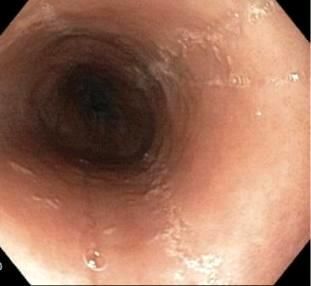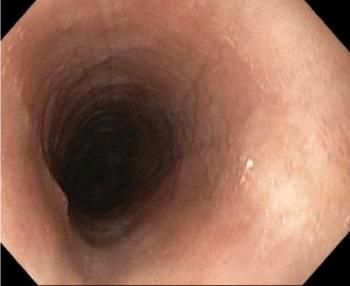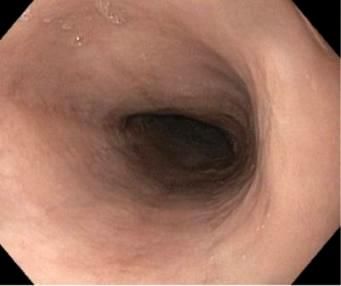Eosinophilic Esophagitis-Related Dysphagia in a Young Woman
EoE is a chronic, immune/antigen-mediated esophageal disease. Clinical symptoms reflect esophageal dysfunction; histology is characterized by eosinophil-predominant inflammation.
A 25-year-old woman presented to the GI clinic complaining of intermittent solid food dysphagia. She is a nonsmoker with a remote history of seasonal allergies. She has no history of asthma or allergies to medications or food. She had been treated 5 years earlier for the same symptoms with an 8-week course of lansoprazole, 30 mg twice daily, which was not effective. An esophagogastroduodenoscopy (EGD) performed at that time showed linear furrowing with trachealization (Figures 1 and 2).

Figure 1

Figure 2
Tissue biopsy specimens from the mid- and distal esophagus confirmed a diagnosis of eosinophilic esophagitis (EoE). Treatment was started with a 6-month course of fluticasone, 220 µg, 2 puffs swallowed twice a day, and lansoprazole, 30 mg twice daily. There was no improvement in symptoms despite the patient’s adherence to therapy.
Over the following 3 years, the patient experienced 4 food impactions and underwent multiple esophageal dilations for symptomatic relief. She did not respond to multiple trials of fluticasone, esomeprazole, and lansoprazole. She also followed dietary modifications, including lactose- and gluten-free regimens, but there was no improvement in symptoms. The patient discontinued all pharmacologic therapy 6 months before her present visit and followed only dietary modifications, including eating small meals with increased liquid intake. Her symptoms remained stable without recurrence of impactions for approximately 4 months.
The patient was stabilized after the current impaction, and treatment was initiated with viscous budesonide, 2 mg twice daily; symptoms improved remarkably within 2 weeks of beginning treatment (Figure 3). Therapy with budesonide was continued for 3 months. There was no recurrence of symptoms. The patient remained completely symptom-free at the 6-month follow-up and has not required further medical management.
Figure 3
Discussion
EoE is a chronic, immune/antigen-mediated esophageal disease. Clinical symptoms are related to esophageal dysfunction, and the histology is characterized by eosinophil-predominant inflammation.1
EoE is well known in the pediatric population, and its prevalence among adults has increased significantly during the past few years.2-5 The estimated mean age of adult disease onset is 38 years; prevalence is estimated at 30 cases per 100,000 persons. Some studies suggest that EoE is the second leading cause of chronic esophagitis, just behind gastroesophageal reflux disease.
Clinical Features
Adults often present with solid food dysphagia, but patients also may present with abdominal discomfort, chest pain, and nausea. The updated consensus recommendations for the management of EoE provided by Liacouras and colleagues1 indicate that patients often present with symptoms suggestive of esophageal dysfunction and 1 or more biopsy specimens show pathological evidence of eosinophil-predominant inflammation. The threshold for diagnosis of EoE is a minimum of 15 eosinophils per high-power field; only the esophagus should be affected. Other etiologies for symptoms also should be excluded, including gastroesophageal reflux disease, non-erosive reflux disease, and obstruction.
Endoscopic evaluation is an essential part of the diagnosis of EoE. Esophageal abnormalities detected during evaluation range from whitish exudates and edema to more chronic changes, such as trachealization and diffuse esophageal narrowing. Some studies suggest that chronic changes resulting from fibrosis are irreversible. However, recent data have shown that with the proper management, fibrosis can be reversed and prevented.6 All patients in whom EoE is suspected should undergo an endoscopic evaluation before treatment. Once the disease is confirmed by pathological samples, treatment should be implemented.
Treatment
Because of the complex pathophysiology of EoE, management should be coordinated with a multidisciplinary team, including an allergist, gastroenterologist, and nutritionist. Food allergies should be ruled out as part of the initial evaluation.
Proton pump inhibitors (PPIs) are a part of the initial treatment in patients with secondary reflux symptoms resulting from esophageal remodeling. Topical corticosteroids have been part of the treatment for patients with EoE since the first case reports.6 Current topical corticosteroid regimens include oral fluticasone spray and oral viscous budesonide. Use of the latter is reported to result in an 89% improvement in symptoms and esophageal histology7; data also are available on long-term maintainence with adequate remission.8
The use of oral fluticasone spray delivered by metered dose inhaler has been associated with poor compliance and technique and limited mucosal absorption. Viscous budesonide, a rapidly absorbed corticosteroid, requires no special instruction; histologic remission is achieved in up to 87% of children with panesophageal diseases.9,10 Corticosteroids used in combination with PPIs are considered first-line therapy for patients with EoE.
References:
1. Liacouras CA, Furuta GT, Hirano I, et al. Eosinophilic esophagitis: updated consensus recommendations for children and adults. J Allergy Clin Immunol. 2011;128:3-20.
2. Noel RJ, Putnam PE, Rothenberg ME. Eosinophilic esophagitis. N Engl J Med. 2004;351:940-941.
3. Straumann A, Simon HU. Eosinophilic esophagitis: escalating epidemiology? J Allergy Clin Immunol. 2005;115:418-419.
4. Veerappan GR, Perry JL, Duncan TJ, et al. Prevalence of eosinophilic esophagitis in an adult population undergoing upper endoscopy: a prospective study. Clin Gastroenterol Hepatol. 2009;7:420-426.
5. Cherian S, Smith NM, Forbes DA. Rapidly increasing prevalence of eosinophilic oesophagitis in Western Australia. Arch Dis Child. 2006;91:1000-1004.
6. Aceves SS, Newbury RO, Chen D, et al. Resolution of remodeling in eosinophilic esophagitis correlates with epithelial response to topical corticosteroids. Allergy. 2010;65:109-116.
7. Straumann A, Conus S, Degen L, et al. Budesonide is effective in adolescent and adult patients with active eosinophilic esophagitis. Gastroenterology. 2010;139:1526-1537.
8. Straumann A, Conus S, Degen L, et al. Long-term budesonide maintainence treatment is partially effective for patients with eosinophilic esophagitis. Clin Gastroenterol Hepatol. 2011;9:400-409.
9. Jendbro M, Johansson CJ, Strandberg P, et al. Pharmacokinetics of budesonide and its major ester metabolite after inhalation and intravenous administration of budesonide in the rat. Drug Metab Dispos. 2001;29:769-776.
10. Dohil R, Newbury R, Fox L, et al. Oral viscous budesonide is effective in children with eosinophilic esophagitis in a randomized, placebo-controlled trial. Gastroenterology. 2010;139:418-429.
2 Commerce Drive
Cranbury, NJ 08512
All rights reserved.
